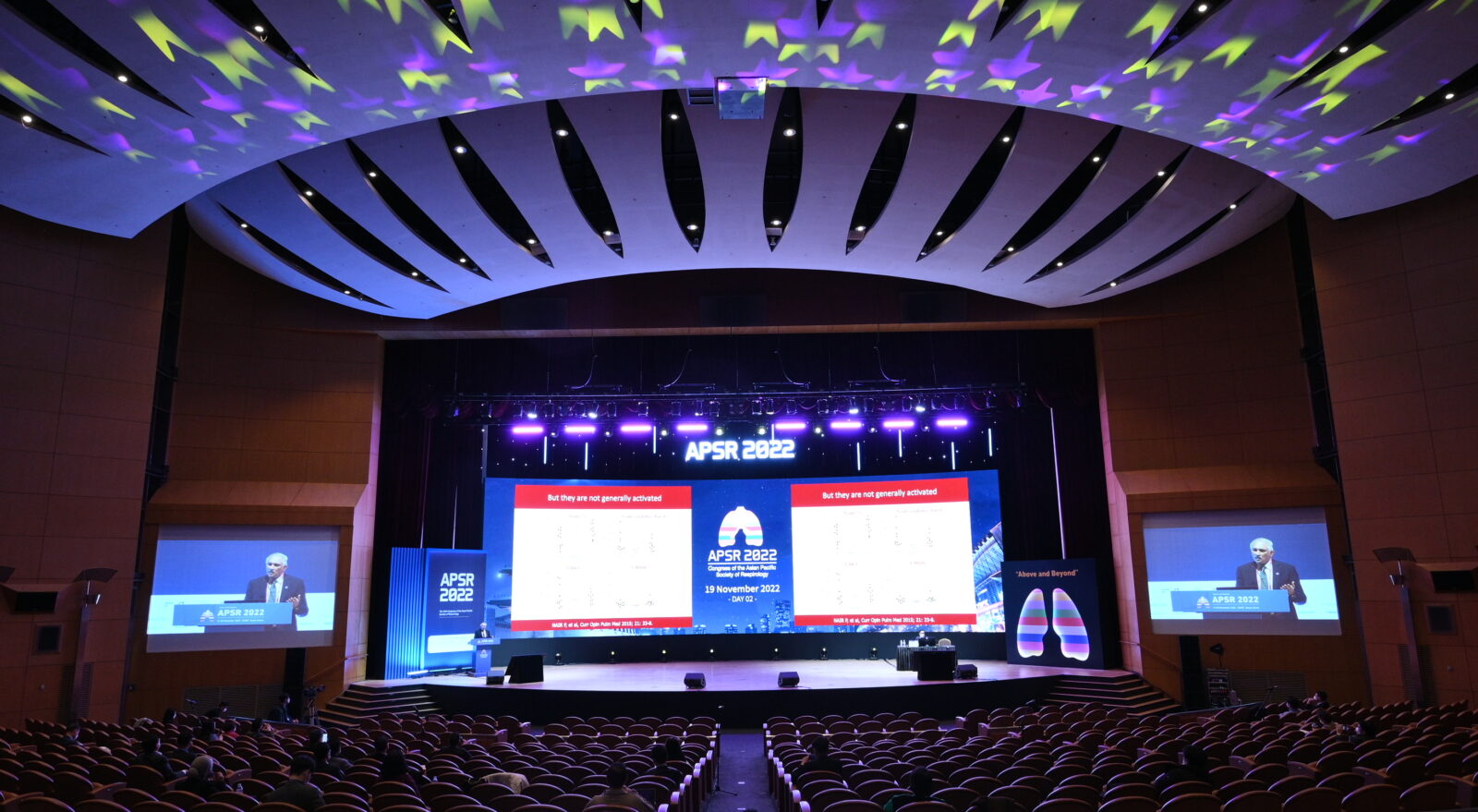Being respiratory experts, at an APSR Congress held in the midst of the 7th epidemic of COVID-19, attendees strictly followed basic quarantine measures. No one took off their masks indoors and all foreign participants were vaccinated against COVID-19.
The Congress featured a total of 80 sessions, including 6 keynote lectures, and the world’s best respiratory experts put their heads together on the latest research topics, leading to the discovery of numerous innovations and possibilities.
Speaking after the Congress, APSR headquarters officials commented that “lectures were conducted in a structured manner to avoid being boring” and elicited “positive feedback from participants, saying they were pleased to have more lively programs than they had before the pandemic.”
Some of the new structure introduced at APSR 2022 included events themed ‘Pros and Cons’, ‘Meet the Professors’ and ‘On-demand Platform’. There were ‘Pros & Cons’ events in four fields, including asthma, interstitial lung disease, lung cancer, and COPD, with real-time voting held on the topics through a mobile app. In ‘Meet the Professors’ sessions, lectures were short and discussions were long. During an hour-long session, the lecture took 20 minutes while the discussion took 40 minutes, with two moderators dividing the speaker’s lecture into two or three sections.
“In the respiratory field, people tend to think that the Asia-Pacific region is academically behind Europe or the United States,” said Jae-Jeong Shim. Shim is Secretary General of APSR 2022 and Chairman of the Korean Academy of Tuberculosis and Respiratory Disease (KATRD), the academic body which organised the ASPR 2022 Congress. “But in reality, this is not the case. The Asia Pacific region can provide high-quality medical care and has made considerable progress in academics.”
Sang-do Lee, President of the KATRD, said that “the Congress has been a venue for all members of the Society to expand globally and advance through active networking. I hope all the experts from around the world will visit Korea and Seoul again after experiencing Korea’s MICE this time.”
Fast-changing dynamic city
APSR 2022 marked Korea’s first time hosting the Congress since 2009. Korea is known as a fast-changing dynamic country that doesn’t stand still, and much had changed in the intervening 13 years. These changes were partially reflected by Seoul being named the ‘Smart City of 2022’ at the Smart City Expo World Congress (SCEWC), an honour that acknowledges the most outstanding initiatives and projects in the innovation and urban transformation industry.
One of the more substantive changes in the last decade-and-a-half has been South Korea’s growing cultural impact on the global stage, whether it be through chart-topping K-Pop bands, Academy Award-winning movies, high-production value TV dramas, or a growing interest in the country’s unique cuisine. Often marketed as K-Culture, South Korea’s growing cultural presence and importance represents a major draw for conference organizers on the search for an interesting MICE destination.
If the success of ASPR 2022 is any barometer, K-Culture constitutes an element that conference attendees are also eager to experience, with many of the APSR 2022 participants travelling with their families precisely for this reason, combining an academic conference with a culturally enriching family holiday.
Foreign participants enjoyed four days of K-Culture around the COEX area and in downtown Seoul. COEX boasts good connectivity with the airport as well as bus and subway stations that allow visitors to reach the popular Gangnam district in less than an hour. Tour programs offered by the Secretariat featured the Bukchon Hanok Village tour, Taekwondo, K-Pop Dance, Han River cruise, and Korean food tour at Gwangjang Market. Seoul offers traditional culture, such as Hanok and Korean food, as well as local culture, but foreign visitors had come prepared with their own to-do and must-see lists, with many preferring K-content filming locations than traditional attractions. South Korea has a good transit infrastructure enabling visitors to travel easily beyond Seoul as well.
KATRD’s Jae-Jeong Shim spoke about this phenomenon:
“The professors who visited Seoul for the Congress 13 years ago said that the city feels familiar and modernized. I am realizing the explosive interest among people all around the world in K-culture. Scholars seem to have notably more reasons to visit Korea, especially Seoul, in addition to reasons to attend academic conferences.”
“Seoul is close to the international airport and offers convenient transportation in the city. Its accommodations are great, with complete MICE infrastructure. Since APSR participants come from all over the world, high satisfaction could not be expected if any of these criteria are not met. So, it was the best destination to host the event.”
An official from the Secretariat said, “many members from all over the world visited the event despite the pandemic. This shows that the level of respiratory science and medical technology in the Asia-Pacific region is world-class. The event showed that the status of K-medical, K-culture, and K-MICE has changed dramatically after the pandemic.”
“I served as the deputy secretary general at APSR 2009 held in Korea,” says Jae-Jeong Shim. “At that time, the Korean Wave was in its infancy. Now that things like K-culture and K-pop have become familiar, if there is an event in Korea, foreign participants want to come.”
Contact: miceseoul@sto.or.kr / www.miceseoul.com/index
